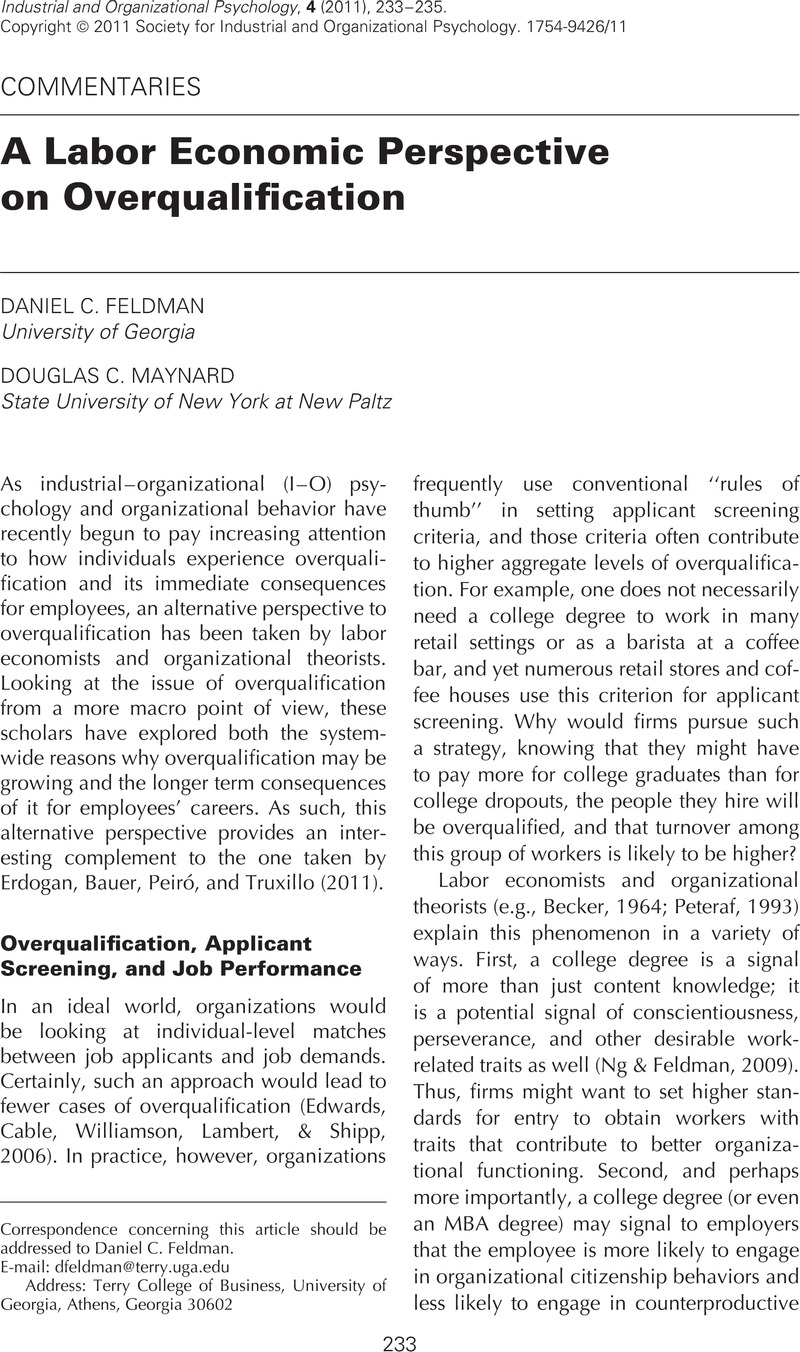Crossref Citations
This article has been cited by the following publications. This list is generated based on data provided by Crossref.
Erdogan, Berrin
Bauer, Talya N.
Peiró, José María
and
Truxillo, Donald M.
2011.
Overqualification Theory, Research, and Practice: Things That Matter.
Industrial and Organizational Psychology,
Vol. 4,
Issue. 2,
p.
260.
Liu, Songqi
and
Wang, Mo
2012.
The Role of the Economic Crisis on Occupational Stress and Well Being.
Vol. 10,
Issue. ,
p.
1.
Okay-Somerville, Belgin
and
Scholarios, Dora
2013.
Shades of grey: Understanding job quality in emerging graduate occupations.
Human Relations,
Vol. 66,
Issue. 4,
p.
555.
G. Martinez, Patricia
L. Lengnick-Hall, Mark
and
Kulkarni, Mukta
2014.
Overqualified? A conceptual model of managers’ perceptions of overqualification in selection decisions.
Personnel Review,
Vol. 43,
Issue. 6,
p.
957.
Kulkarni, Mukta
Lengnick-Hall, Mark L.
and
Martinez, Patricia G.
2015.
Overqualification, mismatched qualification, and hiring decisions.
Personnel Review,
Vol. 44,
Issue. 4,
p.
529.
Thompson, Katina W.
Sikora, David M.
Perrewé, Pamela L.
and
Ferris, Gerald R.
2015.
Employment Qualifications, Person–Job Fit, Underemployment Attributions, and Hiring Recommendations: A three‐study investigation.
International Journal of Selection and Assessment,
Vol. 23,
Issue. 3,
p.
247.
CHU, Fulei
WANG, Rui
and
GAO, Zhonghua
2018.
新员工资质过剩动态变化及作用机制:组织社会化视角.
Advances in Psychological Science,
Vol. 26,
Issue. 12,
p.
2101.
Ma, Chao
Lin, Xiaoshuang
Chen, (George) Zhen Xiong
and
Wei, Wu
2020.
Linking perceived overqualification with task performance and proactivity? An examination from self-concept-based perspective.
Journal of Business Research,
Vol. 118,
Issue. ,
p.
199.
Erdogan, Berrin
Karaeminogullari, Aysegul
Bauer, Talya N.
and
Ellis, Allison M.
2020.
Perceived Overqualification at Work: Implications for Extra-Role Behaviors and Advice Network Centrality.
Journal of Management,
Vol. 46,
Issue. 4,
p.
583.
Erdogan, Berrin
and
Bauer, Talya N.
2021.
Overqualification at Work: A Review and Synthesis of the Literature.
Annual Review of Organizational Psychology and Organizational Behavior,
Vol. 8,
Issue. 1,
p.
259.
Chu, Fulei
Liu, Shuzhen
Guo, Ming
and
Zhang, Qichao
2021.
I am the top talent: Perceived overqualification, role breadth self-efficacy, and safety participation of high-speed railway operators in China.
Safety Science,
Vol. 144,
Issue. ,
p.
105476.
Zhang, Man
Wang, Fan
Weng, Haolin
Zhu, Ting
and
Liu, Huiyun
2021.
Transformational Leadership and Perceived Overqualification: A Career Development Perspective.
Frontiers in Psychology,
Vol. 12,
Issue. ,
Watson, Gwendolyn Paige
Kistler, Lauren D.
Graham, Baylor A.
and
Sinclair, Robert R.
2021.
Looking at the Gig Picture: Defining Gig Work and Explaining Profile Differences in Gig Workers’ Job Demands and Resources.
Group & Organization Management,
Vol. 46,
Issue. 2,
p.
327.
Dar, Nasib
Ahmad, Saima
and
Rahman, Wali
2022.
How and when overqualification improves innovative work behaviour: the roles of creative self-confidence and psychological safety.
Personnel Review,
Vol. 51,
Issue. 9,
p.
2461.
Ma, Xuejun
Khattak, Afraseyab
Ghani, Bilqees
and
Huo, Mongda
2024.
Perceived overqualification in higher education institutions: Enhancing employee innovative behavior via creative self-confidence and harmonious workplace climate.
Current Psychology,
Vol. 43,
Issue. 11,
p.
9826.
Li, Yi
Yan, Menghan
Fang, Jianfeng
and
Wei, Feng
2024.
Voluntary overqualification: conceptualization, scale development and validation.
Chinese Management Studies,
Jahantab, Farid
Erdogan, Berrin
and
Vidyarthi, Prajya R.
2024.
Are We Friends? Relative Overqualification, Citizenship, and the Mediating Role of Friendship Network Centrality.
Journal of Business and Psychology,
Vol. 39,
Issue. 2,
p.
527.
Liao, Meishi
Zhang, Melody Jun
Carnevale, Joel B.
Huang, Chengquan
and
Wang, Lin
2024.
Capable Fish or Deficient Ponds? A Meta-Analysis of Consequences, Mechanisms, and Moderators of Perceived Overqualification.
Journal of Management,



